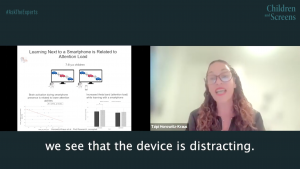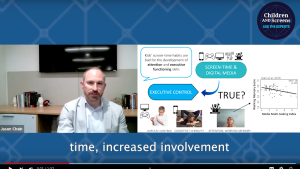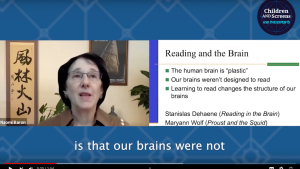
Tzipi Horowitz-Kraus, PhD (Associate Professor, Educational Neuroimaging Group, Faculty of Education in Science and Technology, Faculty of Biomedical Engineering, Technion – Israel Institute of Technology), shares research indicating the impact of smartphone proximity on youth attention (as measured on task-based brain EEG) at #AskTheExperts webinar “Driven to Distraction: Media Use, Attention and Cognition” on April 10, 2024.
Read the Video Transcript
[Dr. Tzipi Horowitz-Kraus] I really want to talk about this particular, freshly-new study where we placed a smartphone next to children participating in a very simple reaction time task. So they’re seeing cars, and they need to push a button when they see a blue car and when they see a red car. It’s relatively simple. But we had two conditions: one condition when the smartphone was next to them, and in the other condition the smartphone was away. Now, there are some behavioral studies like that. Looking at this phenomenon, we see that the device is distracting. However, in this study we used EEG. So we measured brain activation during these two conditions to see whether we do find some neurobiological markers for attention decrease. And we actually found exactly this. When the smartphone was present, there was brain activity that was similar to what we expect in children with attention difficulties. Although these children were typically-developing children, they did not have attention difficulties as compared to the same children doing the same exact task when there was no smartphone in the area.
View the full webinar

Driven to Distraction: Media Use, Attention and Cognition
How do hours spent daily on digital media affect children’s attention spans, multitasking skills, and cognitive functions? How are digital platforms affecting how youth interact with the real world?
Nicholas Carr
Author, Journalist
Susanne Baumgartner, PhD
Associate Professor, Amsterdam School of Communication Research
Taína Coleman, MA, MEd
Educational Specialist, Learning and Development Center, Child Mind Institute
Tzipi Horowitz-Kraus, PhD
Associate Professor, Educational Neuroimaging Group, Faculty of Education in Science and Technology, Faculty of Biomedical Engineering, Technion - Israel Institute of Technology
Tracy Markle, MA, LPC
Founder & Director, Digital Media Treatment & Education Center, Collegiate Coaching Services



